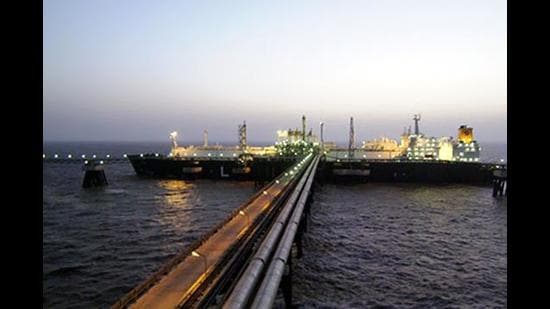To increase the share of gas in its energy mix, India has diplomatic options
The government has a target to increase the share of gas in India’s energy mix from the current 6% to 15% by 2030. The success of this plan depends on the availability of cheap gas
One of the last major political acts of German chancellor Angela Merkel before the end of her tenure was the decision to go ahead with the Nordstream II project. This will bring an additional 55 billion cubic metres (BCM) per annum of Russian gas to Germany through a pipeline under the Baltic Sea, and double the volume of gas Germany currently receives from Russia. She allowed neither American pressure nor Ukraine’s objection to override German interest in energy security.

After her meeting with United States (US) President Biden on July 21, Merkel said, about Nordstream II, “We have come to different assessments”. She visited Ukraine to mollify the authorities. Ukraine, however, feels that the project will undermine the existing pipeline from Russia to Europe, which goes through the country.
Gas is a bridging fuel for the transition to a low-carbon economy, as it is less polluting than coal. Most Western economies have retained gas as a substantial part of their energy basket. It accounts for 34% of the US’s primary energy consumption, 38% of the United Kingdom (UK)’s, and 25% of Germany’s. Germany also has the option of buying American liquefied natural gas (LNG), which Donald Trump was pushing for. But it preferred the pipeline option to meet the bulk of its needs since piped gas is cheaper than LNG for distances up to 2,000 km.
Europe is undergoing a major energy crisis, as the price of electricity has shot up. It went up to $395 a megawatt-hour (MWh) in the UK and €131 a MWh in Germany. The immediate trigger was slowing wind speed. The UK (24%) and Germany (23.7%) depend on wind power to meet a large part of their electricity demand. But underlying this was the upward trend in gas prices since early this year.
European politicians and the media have blamed Russia for the short supply, but Russia denies the charge. Deregulation of the energy market, and growth of the spot market, may have brought about greater competition. However, this has also introduced greater price volatility. The answer, therefore, lies in pipeline contracts, which are concluded on a long-term basis.
India is an LNG importer, which plays a major role in the production of fertiliser and petrochemicals, along with fuelling power plants. Our import requirements are bound to grow. The government has a target to increase the share of gas in India’s energy mix from the current 6% to 15% by 2030. The success of this plan depends on the availability of cheap gas.
LNG prices are subject to market dynamics. LNG is currently trading above $37 per metric million British thermal units (MMBtu) in Asian markets. The availability of piped gas will help introduce both competition and price stability.
India needs both LNG and piped gas. The size of its import requirements is large enough to accommodate both. This is also required to diversify India’s import requirements and avoid undue dependence on one source.
So, what are our choices? India signed an agreement with Turkmenistan to bring gas to India through the Turkmenistan-Afghanistan-Pakistan-India (TAPI) pipeline. This has been on hold due to political uncertainties associated with the route passing through Pakistan. With the rise of the Taliban in Afghanistan, the prospects of importing gas through TAPI have become even more remote.
Myanmar has some offshore gas fields. GAIL has acquired a stake in some of these assets. However, the absence of a pipeline makes it difficult to bring the gas to India.
India could bring gas from the Gulf or Iran through an undersea pipeline. SAGE, an Indian company, has done considerable work in exploring various options. Technology exists for laying deep-sea pipelines. Money could be raised from international markets, once an assurance for gas off-take is given. Oman is keen to supply gas. It is connected with the United Arab Emirates (UAE) and Qatar through the Dolphin pipeline, and can draw upon its gas reserves. The UAE is developing its gas reserves, which will come on-stream in two-three years.
The project is estimated to cost $4.5 billion and the 1,300 km pipeline can be completed in five years, if fast-tracked. It can bring gas worth 31.1 million standard cubic meters per day (mmscmd) to India. Indian companies can produce steel pipelines for the project and will be an expression of Prime Minister Narendra Modi’s Make in India programme.
An alternative route to India is from Iran. Iran has the second biggest gas reserves in the world. The two countries have earlier discussed an Iran-Pakistan-India (IPI) pipeline. This would have been subjected to threats of disruption in the case of an India-Pakistan war. This was a major reason for India’s decision not to go ahead with the project.
Since then, Pakistan has pulled out of this project despite having signed an agreement with Iran. However, a sub-sea pipeline from Chabahar to India will not be burdened by geopolitical tensions. Iran’s proximity to India makes it a competitive source of supply. There could also be an agreement on the nuclear issue with the US. In the case of both routes, the landfall for the pipeline will be the Gujarat coast in India. Gujarat is the hub of the petrochemical industry. The biggest advantage of an under-sea pipeline is that this avoids the geopolitical risks associated with overland routes. India’s energy needs are increasing, as climate concerns mount. Gas is a bridge fuel to a low-carbon economy, and holds the key to India’s transition to one.
DP Srivastava is a former ambassadorThe views expressed are personal



